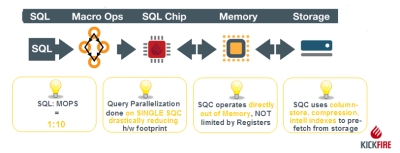Kickfire: MySQL data box for the rest of us

Given all the various technology news in the last two weeks, it would have been relatively easy to overlook a press release from a small startup called Kickfire, which produces an appliance to run MySQL applications.
Snore. Yet another dime a dozen appliance vendor, which will probably go belly up in a year. Who needs an appliance when we have easy enough to configure commodity Linux servers we can buy from Dell, IBM and HP, right?
Wrong.
You see, as it turns out, Kickfire invented a unique database acceleration technology that is able to parallelize query operations on commodity hardware. Much of the database technology employed today is highly performance bound by both I/O and register operations, and is driven by the limitations of memory and CPU. The more memory and faster I/O (or the more spindles on a SAN you have to distribute that I/O) and faster CPU you have, the faster the database. But the operations on the CPU registers to fetch all the columns on a database during query operations are still a significant logjam, classically known as the "Von Neumann Bottleneck".
What Kickfire wants to do is drastically bring the price of high-performance database servers down -- to bring data mining technology to the everyman or the everycompany, as it were, not just the fortune 500. Through the use of a special SQL parallelization processor with on board cache, dedicated memory and tight integration with the MySQL database (click for flash presentation) -- much like how graphics acceleration is performed today on GPUs -- database performance can be drastically improved at a much lower price point than on traditional big iron and midrange database servers.
Kickfire recently published its TPC-H performance results and for an initial product offering, the results are impressive -- the appliance achieved 49,228 QphH@100GB, the highest reported performance result on the 100GB benchmark in the non-clustered category. The price performance of this system was $0.70/QphH@100GB USD.
Now, of course, there are some caveats -- they can't be clustered yet, and they can only use local storage for now. The boxes can currently only use MySQL, not Oracle or DB2 or MS SQL Server, because it required considerable vendor cooperation at the low level to create the query parallelization interface for the database code. However, there is nothing from stopping say, IBM with DB2 and Informix from cooperating with Kickfire, or Oracle and Microsoft doing the same thing with their respective databases. From where I sit, it would seem that the next logical candidates would be SAP/MaxDB and Postgres, both of which are also Open Source. Given how big and expensive SAP configs can be, this might be a nice opportunity for the upstart company.
Right now, Kickfire is aiming its appliance at the 1TB-3TB database market -- which for the Web 2.0 and mid-size application crowd looking to get some very high performance on the cheap, seems like a nice solution. I'm anxiously awaiting second and third generation versions of this box -- ogre sized 4U and rack-sized versions -- with 4 /16 / 32 accelerator chips and SAN connectivity with multi-path I/O. 100TB high performance DB servers for 1/4 or less than today's prices. I'm all for it.
Do I see acquisition target? Oh yes I do.
Do you want a Kickfire box for your enterprise? Talk back and let me know.

![Reblog this post [with Zemanta]](http://img.zemanta.com/reblog_e.png?x-id=95473af1-cc8a-4825-8cd4-7f905eb837a3)